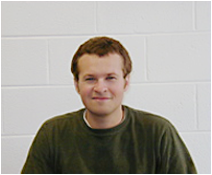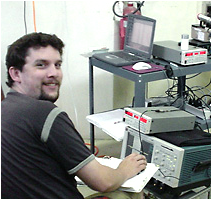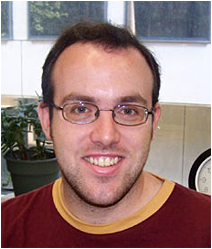 |
 |
 |
 |
 |
 |
 |
 |
 |
 |
|
KICP Workshops & Events
|
PhD Thesis Defenses, 2009 Fabian Schmidt, "Structure Formation in Braneworld Cosmology" June 12, 2009 | 1:30 PM | AAC 123 (Astronomy building)  Scientific Advisor: Scott Dodelson We perform cosmological N-body simulations of the Dvali-Gabadadze- Porrati braneworld model, by solving the full non-linear equations of motion for the scalar degree of freedom in this model, the brane bending mode. While coupling universally to matter, the brane-bending mode has self-interactions that become important as soon as the density field becomes non-linear. These self-interactions lead to a suppression of the field in high-density environments, and restore gravity to General Relativity. The code uses a multi- grid relaxation scheme to solve the non-linear field equation in the quasi- static approximation. We perform simulations of a flat self-accelerating DGP model without cosmological constant. However, the type of non-linear interactions of the brane-bending mode, which are the focus of this study, are generic to a wide class of braneworld cosmologies. The results of the DGP simulations are compared with standard gravity simulations assuming the same expansion history, and with DGP simulations using the linearized equation for the brane bending mode. This allows us to isolate the effects of the non-linear self-couplings of the field which are noticeable already on quasi-linear scales. We present results on the matter power spectrum and the halo mass function, and discuss the behavior of the brane bending mode within cosmological structure formation. We find that, independently of CMB constraints, the self-accelerating DGP model is strongly constrained by current weak lensing and cluster abundance measurements. Related Links: KICP Members: Scott Dodelson KICP Students: Fabian Schmidt Michael Mortonson, "Testing flatness of the universe with probes of cosmic distances and growth" July 15, 2009 | 11:00 AM | LASR conference room Online Materials Scientific Advisor: Wayne Hu When using distance measurements to probe spatial curvature, the geometric degeneracy between curvature and dark energy in the distance-redshift relation typically requires either making strong assumptions about the dark energy evolution or sacrificing precision in a more model-independent approach. Measurements of the redshift evolution of the linear growth of perturbations can break the geometric degeneracy, providing curvature constraints that are both precise and model-independent. Future supernova, CMB, and cluster data have the potential to measure the curvature with an accuracy of s(O K ) 0.002, without specifying a particular dark energy phenomenology. In combination with distance measurements, the evolution of the growth function at low redshifts provides the strongest curvature constraint if the high-redshift universe is well approximated as being purely matter dominated. However, in the presence of early dark energy or massive neutrinos, the precision in curvature is reduced due to additional degeneracies, and precise normalization of the growth function relative to recombination is important for obtaining accurate constraints. Curvature limits from distances and growth compare favorably to other approaches to curvature estimation proposed in the literature, providing either greater accuracy or greater freedom from dark energy modeling assumptions, and are complementary due to the use of independent data sets. Model-independent estimates of curvature are critical for both testing inflation and obtaining unbiased constraints on dark energy parameters. Related Links: KICP Members: Wayne Hu KICP Students: Michael J. Mortonson Robert Friedman, "Measuring the Small Angular Scale Anisotropy with the QUaD Telescope" July 21, 2009 | 5:00 PM | LASR conference  Scientific Advisor: Clement L. Pryke I present measurements of the cosmic microwave background (CMB) radiation temperature anisotropy using the QUaD telescope, a several arcminute resolution bolometric polarimeter operating at 100 and 150 GHz, located at the South Pole. The results presented here are targeted to the multipole range 2000 < ℓ < 3000 using data from QUaD's second and third observing seasons. After masking the brightest point sources in the maps the results are consistent with the primary LCDM expectation alone. I further estimate the contribution of residual (un-masked) radio point sources using a model calibrated to our own bright source observations, and a full simulation of the source finding and masking procedure. Including this contribution slightly improves the h 2 . I then fit a standard SZ template to the bandpowers and see no strong evidence of an SZ contribution, which is as expected for s 8 [approximate] 0:8; the best- fit value for the template amplitude is A SZ = [Special characters omitted.] . Related Links: KICP Members: Clement L. Pryke KICP Students: Robert Friedman Scientific projects: QUaD Tonia Venters, "Cascades of VHE Gamma Rays from Blazars and the Extragalactic Gamma-ray Background" July 28, 2009 | 4:00 PM | AAC 123 Online Materials Scientific Advisor: Angela V. Olinto As very-high-energy photons propagate through the extragalactic background light (EBL), they interact with the soft photons and initiate electromagnetic cascades of lower energy photons and electrons. The collective intensity of a cosmological population emitting at very-high energies (VHE) will be attenuated at the highest energies through interactions with the EBL and enhanced at lower energies by the resulting cascade. We calculate the cascade radiation created by VHE photons produced by blazars and investigate the effects of cascades on the collective intensity of blazars and the resulting effects on the extragalactic gamma-ray background. We find that cascade radiation greatly enhances the collective intensity from blazars at high energies before turning over due to attenuation. The prominence of the resulting features depends on the blazar gamma-ray luminosity function, spectral index distribution, and the model of the EBL. We additionally calculate the cascade radiation from the distinct spectral sub-populations of blazars, BL Lacertae objects (BL Lacs) and flat-spectrum radio quasars (FSRQs), finding that the collective intensity of BL Lacs is considerably more enhanced by cascade radiation than that of the FSRQs. Finally, we discuss the implications that this analysis and upcoming Fermi observations could have for the nature of the EBL, the evolution of blazars, blazar spectra, and other sources of gamma-ray emission. Related Links: KICP Members: Angela V. Olinto KICP Students: Tonia Venters Phil Barbeau, "Neutrino and astroparticle physics with P-type point contact high purity germanium detectors" August 31, 2009  Scientific Advisor: Juan I. Collar The recent development of large mass, low noise P-type point contact (PPC) high purity germanium detectors has opened up a number of new opportunities for experiments in neutrino and astroparticle physics. Several of these experiments have been performed with the earliest prototypes. They are described in this thesis. A measurement for the quenching factor for sub-keV nuclear recoils in germanium detectors is presented. Also discussed is an assessment of the low energy backgrounds at a nuclear power reactor along with the progress that has been achieved towards a measurement of coherent neutrino-nuclear scattering. Using the brief exposure of the detector to a high flux of reactor neutrinos, a limit is placed on the magnitude of a neutrino magnetic moment and a projected limit that can be achieved with a more complete experiment is discussed. A limit is also placed on the magnitude of a continuous energy deposition by reactor neutrinos in the germanium detector. Using the low background data that were obtained at the reactor, limits on light WIMPs as well as dark galactic pseudoscalars are presented, which constrain the physical explanation for a claimed observation of dark matter by the DAMA collaboration. As PPC detectors have been chosen as the preferred detector for the 60 kg Majorana demonstrator double beta decay experiment, projected limits on light WIMPs and dark pseudoscalars are also presented. Finally, bounds are placed on the lifetime of the electron for the "invisible" decay into three neutrinos, and projected limits for such a search using the 60 kg Majorana demonstrator are also presented. Related Links: KICP Members: Juan I. Collar KICP Students: Phil Barbeau Scientific projects: Coherent Germanium Neutrino Technology (CoGeNT) Joaquin D. Vieira, "Extragalactic point source statistics measured with the South Pole Telescope" November 2, 2009  Scientific Advisor: John E. Carlstrom The South Pole Telescope (SPT) has surveyed hundreds of square degrees to milli-Jansky levels at 1.4 mm and 2.0 mm. We report here on sources of point- like emission detected in the 1.4 and 2.0 mm bands in an 87 deg 2 field, centered at R.A. 5 h 30 m , decl. -55°, and observed in 2008. Based on the ratio of flux in these two bands, we are able to separate the detected sources into two populations, one consistent with synchrotron emission from active galactic nuclei (AGN) and one consistent with thermal emission from dust. We present source counts for each population from 11 to 640 mJy at 1.4 mm and from 4.4 to 800 mJy at 2.0 mm. We detect 119 synchrotron-dominated sources and 49 dust-dominated sources at S/N > 4.5 in at least one band. All of the most significantly detected members of the synchrotron-dominated population are associated with sources in previously published radio catalogs and/or in our own long-wavelength follow-up observations. Some of the dust-dominated sources are associated with nearby ( z [Special characters omitted.] 1) galaxies whose dust emission is also detected by the Infrared Astronomy Satellite (IRAS). However, most of the bright, dust-dominated sources have no counterparts in any existing catalog. We argue that these sources represent the rarest, brightest, and possibly strongly-lensed members of the population commonly referred to as sub-millimeter galaxies (SMGs). Because these sources are selected at longer wavelengths than in typical SMG surveys, they are expected to have a higher mean redshift distribution than objects currently in the literature, and may provide a new window on galaxy formation in the early universe. Related Links: KICP Members: John E. Carlstrom KICP Students: Joaquin D. Vieira Scientific projects: South Pole Telescope (SPT) Thomas Downes, " The population of submillimeter galaxies and its impact on the detection of the Sunyaev-Zel'Dovich Effect" November 5, 2009  Scientific Advisor: Stephan S. Meyer The population of submillimeter galaxies (SMGs) informs models of the formation of structure in the universe. It is likely that SMGs are the progenitors of systems like the Milky Way because their spectra imply the high star formation rates necessary to form the requisite number of stars. Until recently millimeter/submillimeter experiments did not have the sensitivity to image both wide and deep to distinguish between competing models of galaxy evolution. AzTEC is an array instrument operating at 1.1mm that has the necessary sensitivity and dedicated telescope time and has begun making groundbreaking contributions to the field. Furthermore, SMGs are an expected foreground to the detection of the Sunyaev-Zel'dovich Effect (SZE) in clusters of galaxies. In particular, at wavelengths longer than 1.4mm the positive flux of SMGs below an instrument's sensitivity threshold will counteract the decrement expected from the SZE. The detection of galaxy clusters is a promising approach to understanding the expansion history of the universe and putting constraints on s 8 as well as on the properties the dark energy. We present below the results of an analysis of AzTEC surveys for SMGs in galaxy cluster environments as well as "blank" fields far away from clusters. We compare the two results and those of previous surveys and estimate their implications for the ability of a blind survey at 2mm to detect the SZE in clusters. We find that the noise contributions of SMGs to SZE detection are small compared to the sensitivity of existing surveys, such as that of the South Pole Telescope. Related Links: KICP Members: Stephan S. Meyer KICP Students: Tom Downes |





 Overview
Overview